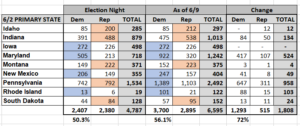Imagine waking up the morning after Election Day without knowing who won the Presidential election. This actually happened back in November 2000, when a series of reporting errors on Election Night eventually led to the infamous “Florida recount”, as a late evening lead by George W. Bush in that state rapidly disintegrated to less than a 1,000 vote lead in the early morning hours, thus causing Al Gore to retract his concession to George W. Bush and the recount (and its voluminous litigation) to last for five weeks.
Such a scenario is not out of the realm of possibility this year unless one of the candidates can establish a clear lead in the Electoral College the first few hours after polls first close in Indiana and Kentucky. Although the way the 50 states conduct their elections has substantially changed since that infamous 2000 Presidential race.
In the “old days”, nearly everyone waited in line on Election Day to vote at their voting precinct, with only a few people voting “absentee”, because a valid reason for not being able to vote in person on Election Day was required. That changed when in 1980 California removed the “excuse requirement” for absentee voting. In the late 1980s, Texas became the first state to offer in person early voting, and in 1995, Oregon conducted its first “mail in” election. Since then, numerous states have adopted one or a combination of these types of voting, and before the pandemic, only about 15 states (mainly in the Northeast and the South) still conducted elections the “old fashioned way” with Election Day voting and an excuse required to vote absentee (Louisiana also implemented in person early voting about 15 years ago in the aftermath of Hurricane Katrina, and it first took off during the 2007 statewide elections).
The coronavirus pandemic has rewritten the election rules, however. Given concerns about proper “social distancing”, there have been consistent problems with states attempting to conduct primaries with Election Day voting (of course, it doesn’t help either that to reduce the spread of infection, many voting precincts have been consolidated). At the same time as those Election Day problems are reoccurring (in yesterday’s primaries, long polling lines were AGAIN a problem, this time in Georgia), other states decided instead to conduct their elections either largely or entirely by mail.
While mail in balloting does eliminate the long lines at polling places (since, of course, you can “vote” from the convenience of your home), it is not necessarily a panacea for how to conduct elections: (1) changing to all mail ins is a significant “paradigm shift” for both voters and elections administrators, which means there needs to be “transition time” for voters and elections administrators to learn the “new system”, and (2) mail in ballots don’t get counted as quickly as ballots cast on a machine, thus creating an element of delay to the final vote count.
A perfect example of the downside of mail in voting is California, where many (though not all) prefer to vote by mail. In the March 5 Presidential/Congressional/legislative primary election, 5.8 million voted for President, but only 3 million (i.e., just over half) of that vote was counted by Election Night. The remaining 2.8 million votes took 7 weeks to count – in other words, the last mail ballots for the March 5 primary weren’t counted until April 24.
California is not an isolated example either. When “Election Season” restarted last Tuesday on June 2, nine states held election contests, and there was a greater preponderance of mail in voting. While 4.8 million votes were reported on Election Night, the expansion of mail in voting (particularly in Maryland and Pennsylvania) created a mountain of uncounted votes which are taking time to count. In fact, in the seven days since that election, an additional 1.8 million votes have thus far been counted.
Why would this delayed counting matter ? While many of the states on the June 2 primary are likely to be solidly for either Biden or Trump this November, it is also a fact that Pennsylvania (which Trump carried by 44,300 votes in 2016) expanded its mail in voting, and in the week since those ballots started to be counted, the 1.5 million votes counted on Election Night has increased to 2.5 million. Those 958K additional votes counted since Election Night were 68% Democratic. In other words, it’s possible for multiple states on Election Night to have a substantial number of uncounted votes. And while the initial returns may show either Trump (or Biden) in the lead, those last minute mail in ballots could “flip” the results. Georgia is another example: Trump carried this state by 212,000 votes in the 2016 Presidential election and is a state where in person early voting is popular. However, for this year’s primary just held last night, the 394K voting in person and 44K voting by mail in 2016 became 329K voting in person while mail in voting increased to 1,190 million – in other words, a 27 fold increase in mail in voting. Since a mail in volume like this is far more than the Trump margin in 2016, counting those ballots could again make this an uncalled state for several days after Election Day. And what could happen in Georgia after Election Day (i.e., a delayed vote count/race call) could also be the case in “swing states” like Florida and Arizona which historically have had a substantial mail in voting population. Furthermore, with mail balloting being expanded this year in many jurisdictions, it is possible that every swing state may remain uncalled on Election Night as those votes are being tallied.
The point of this article is that the coronavirus pandemic has almost instantly changed how Americans vote, and the likelihood of delayed counting from an expanded mail in vote volume means this Presidential election may be more of an “Election Week’ than “Election Night”, and it’s important to be ready for that likelihood.

